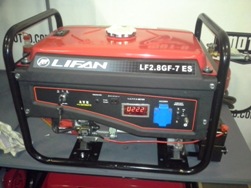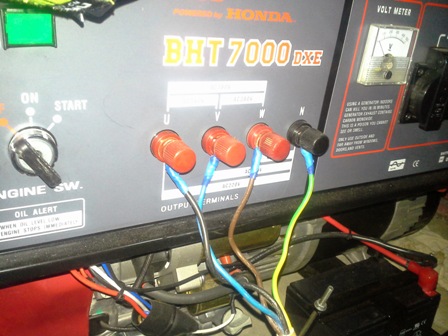Categories: Featured Articles » Autonomous power supply
Number of views: 16536
Comments on the article: 9
How to choose a generator - 10 questions and answers
 How much power should the generator take? How to install it? Where to connect it? What can be connected to an electric generator? ... In this article we have collected 10 most popular questions and tried to answer them in a simple, understandable language. We hope that the answers to them will help you in choosing an electric generator. Here are 10 basic questions regarding the generator and the answers to them.
How much power should the generator take? How to install it? Where to connect it? What can be connected to an electric generator? ... In this article we have collected 10 most popular questions and tried to answer them in a simple, understandable language. We hope that the answers to them will help you in choosing an electric generator. Here are 10 basic questions regarding the generator and the answers to them.
1. How powerful generator should I get?
The estimated power of the generator depends on the amount of electrical loads that you want to use simultaneously. Power is measured in watts (watts). First, add up all the loads that you intend to use at the same time. Then, as a precaution, find out which household electrical appliances in your house can have large inrush currents (refrigerators, air conditioners, pumps) Add all this to the total.
The fact is that some devices, such as air conditioning, refrigerators, pumps, tend to use a lot of energy at start-up (start-up) - usually 2-3 times more than they use during operation.
You must make sure that your generator can normally tolerate the launch of relatively powerful devices, make sure that they do not overload the system while starting all the devices at the same time.
The generator has two units that determine its power: nominal and maximum. The generators are provided with overload protection, which can work at the time of simultaneous start of electrical appliances. Therefore, you should purchase a generator with some power reserve.
2. What loads should be supplied from the generator?
Based on our own many years of experience in installation and maintenance of generators, we recommend that you provide the main consumers, which include:
1) Heating and all heat related appliances (boiler, pumps, etc.).
2) A pair of lighting circuits.
4) Fridge.
5) Microwave.
6) Garage Doors.
7) Well pump.
8) Alarm.
If there is enough backup generator power, then secondary loads can be connected: a drainage pump, ventilation ...
3. How to calculate all this?
Equipment manufacturers indicate the power of the devices on the devices themselves or in the product passport. Also on many sites you can find an online calculator that will help you choose the power of the generator.

4. Do I need to hire an electrician to connect the generator to the electrical network at home?
The safest way to connect the generator to the electrical network of the house is to use an additional device - ATS - automatic inclusion of the reserve. ATS is connected to the mains after the meter and the generator is connected directly to the automation. When you start the generator, it makes it disconnects the house from the city power supply and supplies only the electrical appliances that you have allocated. Thus, the generator will not be overloaded.
Read more about this here: ATS automation for generators
If you are an amateur electrician, you have some knowledge of electricity but have no experience in installing equipment of this type, it is best to consult a specialist for installation of equipment. Indeed, the reliability of all the energy systems of your home depends on how competently and efficiently the installation and commissioning of the equipment is made.
5. Can't I just plug the generator into a power outlet?
No and no again! We have already seen many times what this could lead to. This is very dangerous for a number of reasons.For example, if someone forgets to turn off the main circuit breaker, the generator can send electric power to an external network with all the ensuing consequences, if repairs are being carried out on the line at this time ...
The main points that you need to know for the correct connection of the generator are discussed in this article: How to connect the generator to the network at home
6. What is the difference between a standby generator and a standby generator?
The backup generator is installed permanently and is designed to provide most electrical appliances. The emergency generator is a small, portable unit that can be carried outside the premises and connected to the ATS. Or it can be connected to electrical loads through extension cords.
7. If it is raining or snowing outside, can I put the generator in the garage and start it there while the door remains open?
Not. Never run the generator inside the house, inside the garage, under a canopy, on the porch, inside the porch or near an open window. Even with an open garage, carbon monoxide (CO) contained in the exhaust gas of a generator can cause poisoning or, in the worst case, result in death.

8. What other safety tips should I remember?
If the generator is installed permanently, use smoke detectors and carbon monoxide detectors, at least when using the generator. The generator should be located at least three meters from the house to minimize the risks of carbon monoxide poisoning (CO). Never fill fuel into the generator until it has cooled.
9. The generators are working quite loudly. What can be done about this?
Unfortunately, there are not many options. Use inverter generators, where the speed depends on the load. You can also purchase generators in a soundproof casing. In addition, you can purchase a special soundproof weatherproof container in which the generator is placed.
Some artisans are experimenting with additional silencers from motorcycles and ATVs. This can be done if you have the necessary skills. But keep in mind: in most cases this will invalidate the generator warranty.
The easiest way to reduce noise from a mini-power plant is to reduce the electrical load.
10. Do I need to ground the generator?
Follow the instructions in the instruction manual. If the manual requires grounding the generator, do it. The easiest way is to connect a wire with a cross section of 4-6 mm to the ground terminal on the generator. Connect the wire to a copper or iron 1.5 m rod, which can be driven into the soil near the generator.
As an alternative to the ground rod, you can connect the ground wire from the generator to ground bus inside the house in the main distribution board.
Read also on this topic:What to consider when choosing a generator
One of the possible solutions to the problem with low-quality voltage generated by generators: How to get high-quality electricity from a generator
See also at bgv.electricianexp.com
:
